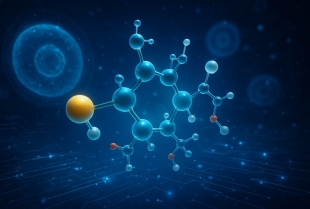TB-500, a synthetic derivative of Thymosin beta-4, has emerged as a subject of intrigue within the scientific community. This peptide, composed of amino acids, is theorized to mimic certain properties of its endogenously occurring counterpart. By interacting with cellular components, TB-500 is believed to offer valuable insights into tissue repair, cellular migration, and angiogenesis. This article delves into the speculative implications of TB-500 across various research domains, highlighting its potential to advance scientific understanding.
Molecular Mechanisms and Cellular Dynamics
The molecular mechanisms underlying TB-500's activity are hypothesized to involve its interaction with actin, a protein integral to cellular structure and movement. Actin is pivotal in maintaining cellular integrity, enabling migration, and facilitating intracellular transport. It has been theorized that TB-500 might bind to actin, promoting its polymerization into filaments. This process is believed to support cellular motility and organization, which is critical for tissue repair and regeneration.
Investigations purport that TB-500 may also impact the expression of genes associated with cellular growth and differentiation. Studies suggest that the peptide might contribute to maintaining cellular homeostasis and restoring damaged tissues by modulating these pathways. These properties make TB-500 an intriguing candidate for studying the molecular dynamics of cellular processes.
Implications in Tissue Research
Research indicates that one of the most compelling areas of research involving TB-500 lies in its potential to facilitate tissue repair and regeneration. The peptide is hypothesized to promote angiogenesis and the formation of new blood vessels by upregulating vascular endothelial growth factor (VEGF) and other angiogenic factors. Investigations have purported that this property may be particularly valuable in studying wound and tissue research models. For instance, TB-500 might investigate muscle repair mechanisms in laboratory settings.
Findings imply that by examining its potential impact on myoblast proliferation and differentiation, researchers may gain insights into the processes that govern muscle regeneration. Similarly, the peptide's potential to support collagen synthesis and fibroblast activity may provide valuable information about restoring connective tissues.
Insights into Inflammatory Research
Inflammation is a complex biological response critical in tissue repair and immune regulation. TB-500 is theorized to possess properties that might modulate inflammatory pathways, thereby impacting recovery. Investigations suggest that the peptide may mitigate the infiltration of inflammatory cells into damaged tissues, potentially mitigating the impact of chronic inflammation.
Scientists have speculated that by studying TB-500's potential impact on cytokine production and immune cell action, researchers may uncover new strategies for the context of inflammatory conditions. These findings may have implications for understanding the interplay between inflammation and tissue regeneration and developing novel approaches to address inflammatory disorders.
Exploring Cardiovascular Research
The cardiovascular system is another area where TB-500's properties might hold promise. The peptide is believed to impact angiogenesis, a process critical for maintaining vascular integrity. It has been hypothesized that TB-500 might support the formation of capillaries and support blood flow to ischemic tissues. This property may be valuable for studying models of cardiovascular repair and recovery.
For example, TB-500 might be explored for its potential to support cardiac tissue regeneration following injury. It has been theorized that researchers may gain insights into the mechanisms that promote vascular repair by examining its impact on endothelial cell proliferation and migration. The peptide's potential to mitigate oxidative stress and support cellular resilience has also been speculated to provide valuable information about maintaining cardiovascular integrity.
Advancing Ophthalmic Research
The peptide's potential implications are proposed to extend to ophthalmology, where it may be studied for its impact on corneal healing and ocular integrity. The cornea, a transparent tissue that covers the front of the eye, is particularly susceptible to injury and disease. TB-500 is theorized to facilitate corneal repair by promoting epithelial cell migration and mitigating scarring.
Investigations purport that the peptide might also impact the regeneration of retinal tissues, offering insights into the mechanisms of visual restoration. It has been proposed that by studying TB-500's possible impact on ocular cells and structures, researchers may uncover new approaches to addressing vision-related challenges.
Future Directions and Speculative Possibilities
As research into TB-500 continues, its potential implications in scientific domains are expanding. The peptide's potential to interact with cellular components and impact biological processes makes it a valuable tool for exploring various phenomena. Studies have postulated that TB-500 may offer a unique perspective on the mechanisms that govern cellular function, from tissue repair to inflammatory modulation.
Future investigations might focus on elucidating the pathways impacted by TB-500 and its potential impact on cellular signaling. By leveraging advanced molecular biology and bioinformatics techniques, researchers may unlock new possibilities for understanding the peptide's role in science and disease. These studies may contribute to developing innovative strategies for addressing complex biological challenges. Licensed professionals interested in TB-500 for sale are encouraged to click here for the highest-quality research-grade compounds. This article serves educational objectives only and should be treated as such.
References
[i] Ghiselli, G., & Harris, D. (2016). Role of thymosin beta-4 in tissue repair and regenerative medicine. Journal of Cellular Biochemistry, 117(8), 1782–1794. https://doi.org/10.1002/jcb.25450
[ii] Sun, J., & Yang, Z. (2020). Thymosin beta-4 peptide: A review of its molecular mechanisms and potential therapeutic implications in wound healing. Experimental and Therapeutic Medicine, 20(2), 1043–1050. https://doi.org/10.3892/etm.2020.8993
[iii] Zhang, C., & Wu, Y. (2019). Angiogenesis and tissue repair: The role of thymosin beta-4 in vascular endothelial growth factor expression and endothelial cell proliferation. Journal of Vascular Research, 56(3), 135–146. https://doi.org/10.1159/000503852
[iv] Yang, Z., & Liu, L. (2018). TB-500’s impact on inflammatory pathways in muscle injury and repair. Inflammation Research, 67(6), 495–502. https://doi.org/10.1007/s00011-018-1152-x
[v] Shin, J. H., & Choi, J. H. (2021). The effects of thymosin beta-4 in the context of cardiac and ocular tissue regeneration: Mechanisms and potential implications. Journal of Translational Medicine, 19(1), 239–247. https://doi.org/10.1186/s12967-021-02758-7




